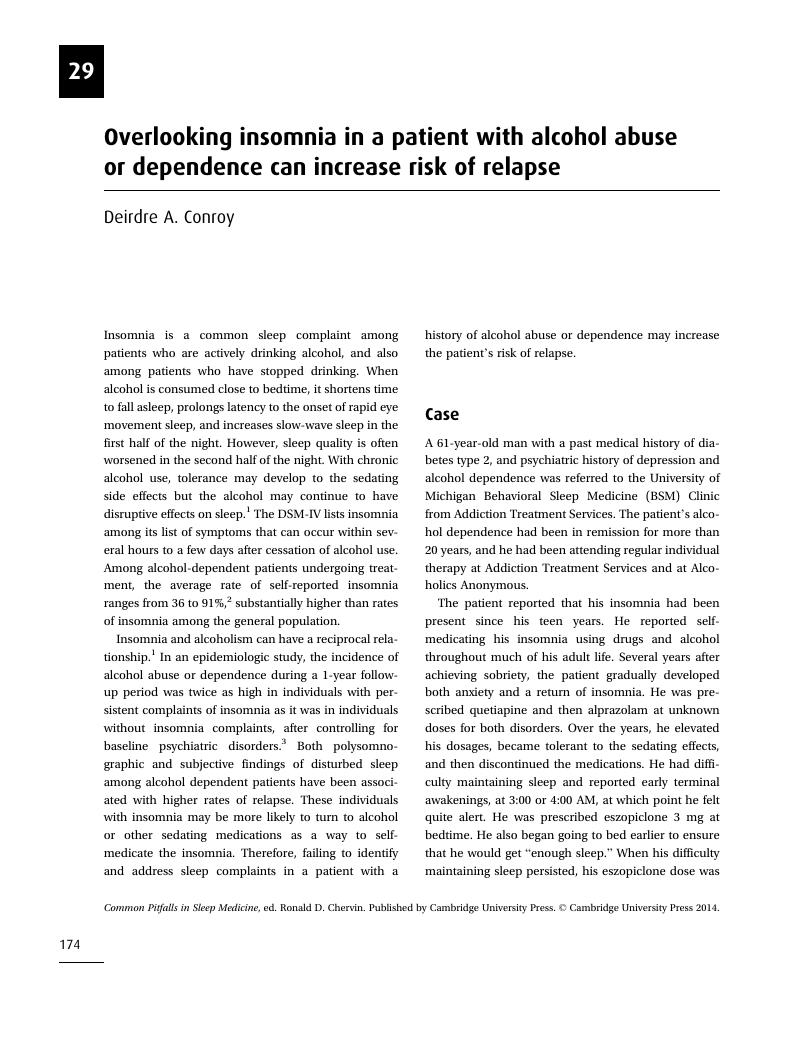Book contents
- Common Pitfalls in Sleep Medicine
- Common Pitfalls in Sleep Medicine
- Copyright page
- Contents
- Contributors
- Preface
- Acknowledgements
- 1 Introduction: the complexity, challenges, and rewards of effective sleep medicine
- Section one Sleepiness versus fatigue, tiredness, and lack of energy
- Section two Assessment of daytime sleepiness
- Section three Diagnosis of narcolepsy
- Section Four Diagnosis of obstructive sleep apnea
- Section Five Positive airway pressure to treat obstructive sleep apnea
- Section Six Alternatives to positive airway pressure in the treatment of obstructive sleep apnea
- Section Seven Diagnosis and treatment of chronic insomnia
- 26 A sleep study is often unnecessaryin a patient with chronic insomnia
- 27 Chronic use of hypnotics is unnecessary and can be counterproductive
- 28 Overlooking insomnia in a depressed patient can interfere with effective treatment for the mood disorder
- 29 Overlooking insomnia in a patient with alcohol abuse or dependence can increase risk of relapse
- 30 The option of cognitive behavioral therapy should not be ignored simply because a patient has medical reasons for insomnia
- Section Eight Restless legs syndrome and periodic leg movements
- Section Nine Parasomnias
- Section Ten Circadian rhythm sleep disorders
- Section Eleven Missed diagnoses of obstructive sleep apnea can exacerbate medical and neurologic conditions
- Section Twelve Sleep in children
- Section Thirteen Sleep in older persons
- Index
29 - Overlooking insomnia in a patient with alcohol abuse or dependence can increase risk of relapse
from Section Seven - Diagnosis and treatment of chronic insomnia
Published online by Cambridge University Press: 05 April 2014
- Common Pitfalls in Sleep Medicine
- Common Pitfalls in Sleep Medicine
- Copyright page
- Contents
- Contributors
- Preface
- Acknowledgements
- 1 Introduction: the complexity, challenges, and rewards of effective sleep medicine
- Section one Sleepiness versus fatigue, tiredness, and lack of energy
- Section two Assessment of daytime sleepiness
- Section three Diagnosis of narcolepsy
- Section Four Diagnosis of obstructive sleep apnea
- Section Five Positive airway pressure to treat obstructive sleep apnea
- Section Six Alternatives to positive airway pressure in the treatment of obstructive sleep apnea
- Section Seven Diagnosis and treatment of chronic insomnia
- 26 A sleep study is often unnecessaryin a patient with chronic insomnia
- 27 Chronic use of hypnotics is unnecessary and can be counterproductive
- 28 Overlooking insomnia in a depressed patient can interfere with effective treatment for the mood disorder
- 29 Overlooking insomnia in a patient with alcohol abuse or dependence can increase risk of relapse
- 30 The option of cognitive behavioral therapy should not be ignored simply because a patient has medical reasons for insomnia
- Section Eight Restless legs syndrome and periodic leg movements
- Section Nine Parasomnias
- Section Ten Circadian rhythm sleep disorders
- Section Eleven Missed diagnoses of obstructive sleep apnea can exacerbate medical and neurologic conditions
- Section Twelve Sleep in children
- Section Thirteen Sleep in older persons
- Index
Summary

- Type
- Chapter
- Information
- Common Pitfalls in Sleep MedicineCase-Based Learning, pp. 174 - 177Publisher: Cambridge University PressPrint publication year: 2014

